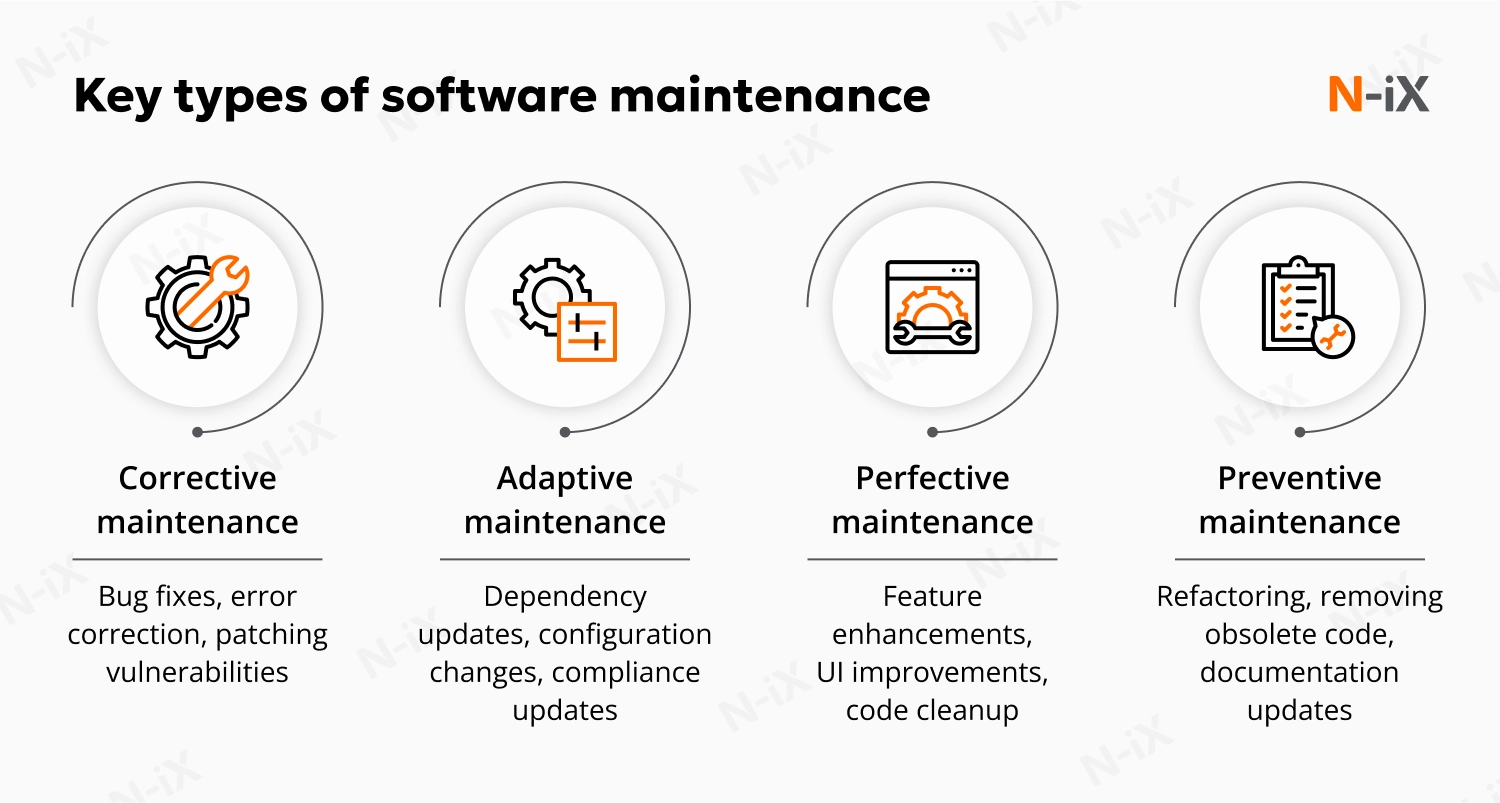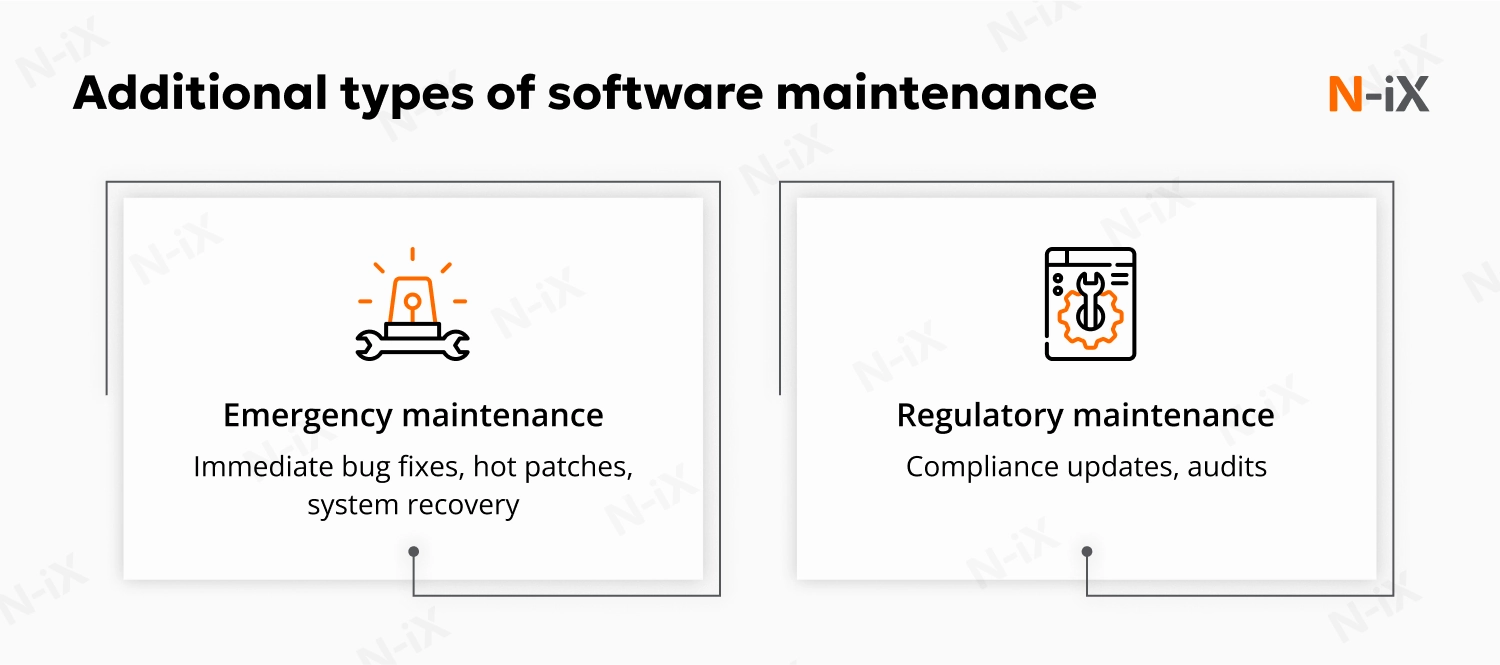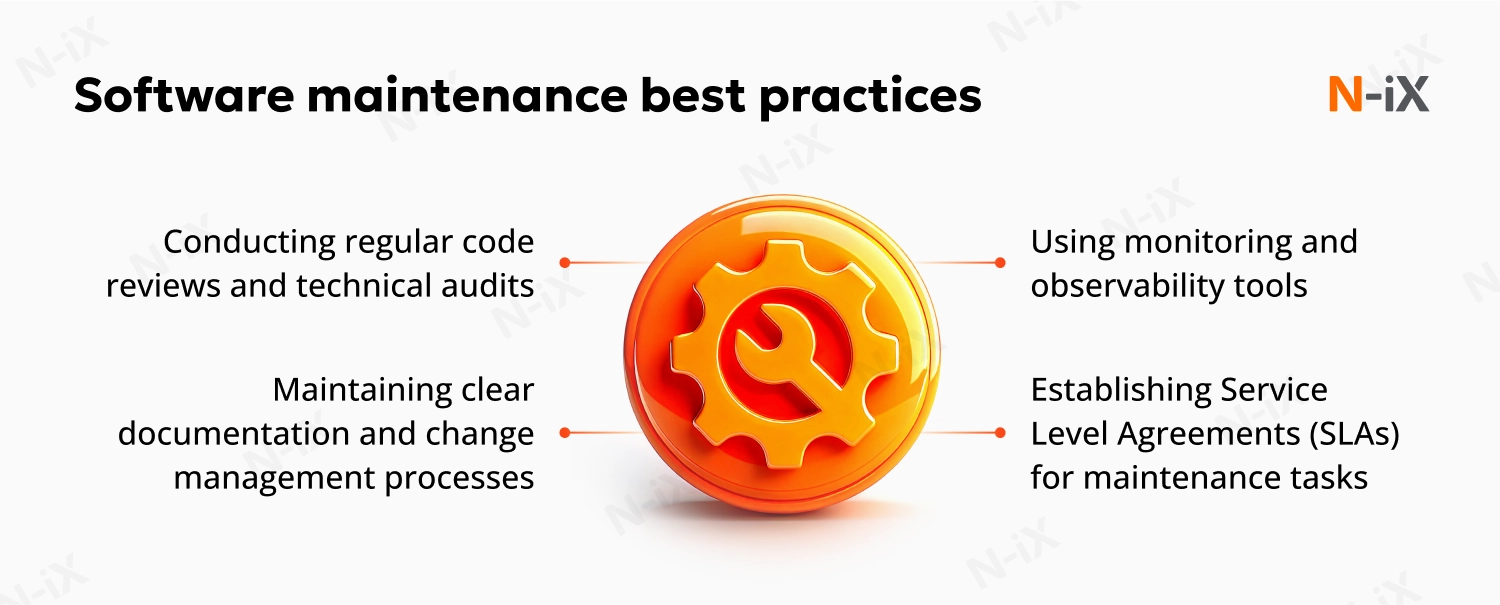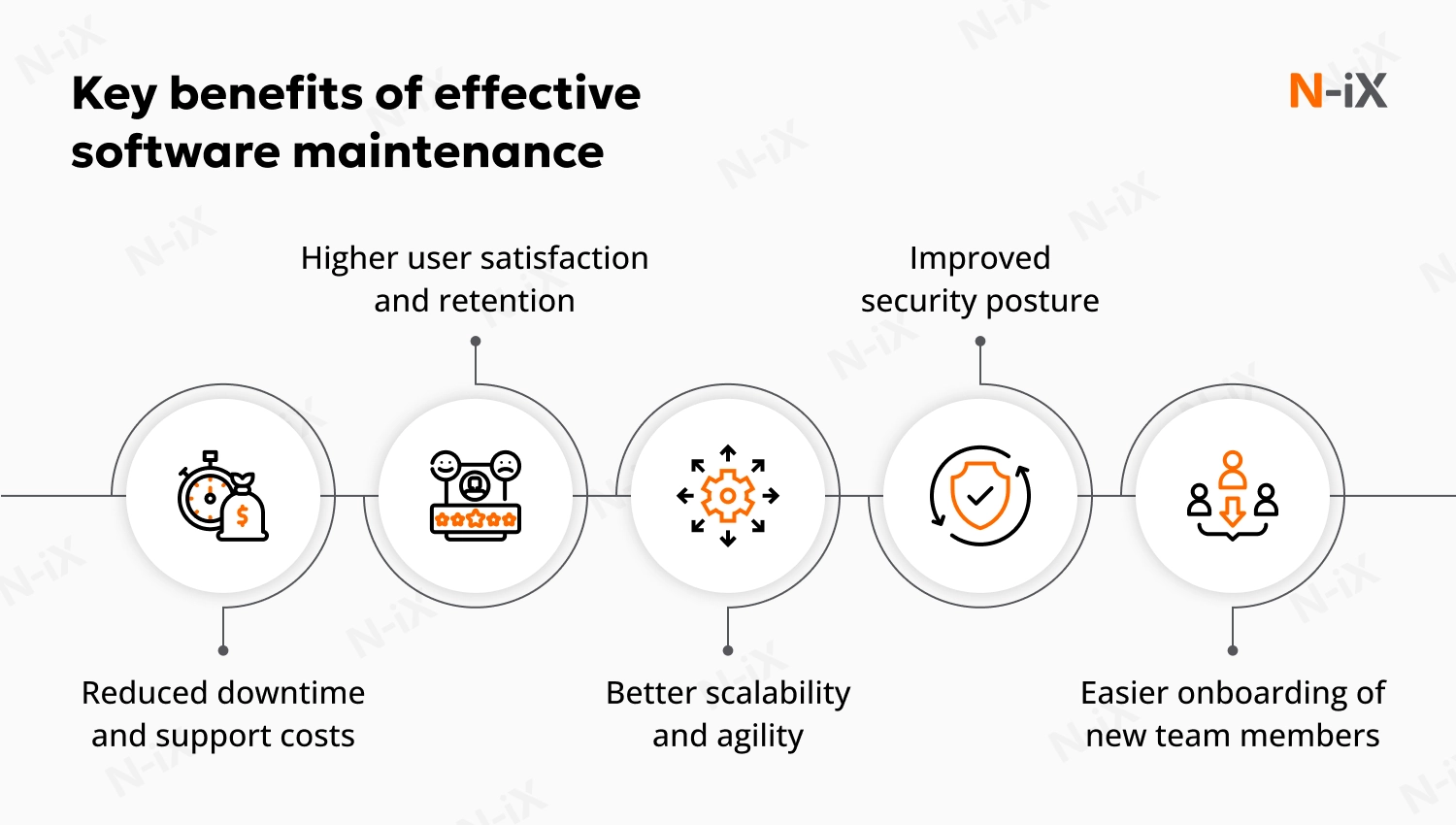Software deployment marks just the beginning of your product's journey. The way you maintain your software after launch shapes its long-term stability, performance, and ability to adapt to evolving business needs. O'Reilly's 60/60 rule shows that software maintenance costs account for 60% of a product's lifecycle expenses. That’s why maintenance requires not just technical upkeep of your software engineering solution, but a plan for ongoing improvement, stability, and business alignment.
This guide explores how various types of software maintenance can help enterprise leaders reduce long-term costs, minimize technical debt, and keep their systems aligned with changing business requirements.
With expert tips from N-iX, you will uncover practices that make software maintenance a driver of software reliability, scalability, and business impact. Let’s dive in.
What is software maintenance?
Software maintenance covers all modifications made after deployment and goes far beyond bug fixing. It’s a structured, ongoing process that ensures your systems remain functional, secure, and aligned with evolving business needs. Each maintenance cycle typically begins with a change request, followed by in-depth code analysis to implement updates without disrupting stability.
Why does software maintenance matter for enterprises?
Software maintenance plays a critical role in ensuring long-term system performance and business continuity. Effective maintenance helps businesses:
- Minimize unplanned downtime and avoid costly disruptions;
- Strengthen security by addressing emerging threats;
- Ensure ongoing compliance and reduce regulatory risks;
- Extend the lifespan of software and defer major replacements;
- Drive continuous improvement and stay competitive in evolving markets.
Neglecting maintenance leads to growing technical debt, which gradually undermines system performance, security, and alignment with business objectives. Organizations that invest in several types of software maintenance are better positioned to scale, innovate, and achieve their long-term goals.
What are the types of software maintenance?
Effective resource planning starts with understanding the different types of software maintenance and when each is needed. According to the ISO/IEC 14764 specification, software maintenance splits into four key categories:
Corrective maintenance
This type of maintenance focuses on restoring expected functionality by addressing bugs, logic errors, and system faults identified after deployment. It plays a crucial role in maintaining system stability and reliability, especially when failures disrupt normal operations. While corrective maintenance is essential, relying on it alone may point to deeper issues in code quality or insufficient testing practices.
- Key activities: Debugging, deploying patches, and applying quick fixes to repair defects and restore functionality.
- Trigger: Usually triggered by user reports, QA feedback, or system monitoring alerts.
- Example: Resolving a login failure that occurs following the release of a new software version.
Adaptive maintenance
Adaptive maintenance ensures that your software remains compatible with changes in its operating environment, such as new OS versions, third-party APIs, or updated regulations. It helps maintain smooth operations and business continuity as external conditions evolve.
- Key activities: Upgrading dependencies, adjusting configurations, and implementing compliance-related updates.
- Trigger: Triggered by changes in platforms, technology stacks, or regulatory standards like GDPR.
- Example: Updating cloud infrastructure integration due to the deprecation of a specific AWS service.
Perfective maintenance
The key goal of perfective maintenance is to enhance software functionality, performance, and user experience based on evolving business needs and user feedback. Rather than fixing errors, it drives continuous improvement by refining features, optimizing performance, and aligning the product with shifting market expectations. This proactive approach helps keep the software competitive and relevant over time.
- Key activities: Adding new features, optimizing algorithms, improving user interfaces, and cleaning up code for better readability and maintainability.
- Trigger: Typically driven by product growth, insights from user behavior, or strategic roadmap planning.
- Example: Improving page load speed or redesigning a dashboard layout to enhance usability and meet updated user expectations.
Reduce your technical debt—download the guide now!


Success!

Preventive maintenance
Preventive maintenance is a forward-looking approach that focuses on identifying and addressing potential issues before they impact system performance. It aims to reduce technical debt, improve maintainability, and ensure long-term system stability. By taking proactive steps during the early stages, teams can prevent costly disruptions, streamline future updates, and extend the lifecycle of the software.
- Key activities: Code refactoring, removing obsolete or risky components, updating documentation, and improving architectural consistency.
- Trigger: Typically initiated after code reviews, technical audits, or architectural assessments that reveal potential risks.
- Example: Rewriting legacy modules to reduce the likelihood of future outages and simplify future development work.

Additional types of software maintenance
While the four primary types of maintenance in software engineering cover most maintenance needs, there are two additional categories that have significant operational and compliance implications for enterprises.
Emergency maintenance
Emergency maintenance is one of the types of system maintenance in software engineering that addresses critical system failures that require immediate, unplanned intervention to prevent major disruptions. These situations fall outside regular maintenance cycles and often involve urgent fixes under high pressure. Even with strong preventive strategies in place, emergencies can happen. This makes it vital to have defined escalation procedures, rapid-response teams, and contingency plans ready.
- Key activities: Immediate bug fixes, hot patching, infrastructure restoration, and issue containment.
- Trigger: Typically caused by system outages, security breaches, or severe performance degradation impacting core business functions.
- Example: A critical security breach requiring immediate patching to prevent data loss or a system failure disrupting core business operations during peak hours.
Regulatory maintenance
Among all the types of maintenance in software engineering, regulatory maintenance is the one that ensures that software remains compliant with evolving legal requirements and industry standards. It is essential for companies operating in highly regulated sectors, where data protection, audit readiness, and stakeholder trust are non-negotiable.
- Key activities: Implementing or updating controls based on frameworks such as NIST, PCI-DSS, HIPAA, or GDPR; auditing configurations; and documenting compliance evidence.
- Trigger: Driven by regulatory updates, internal risk assessments, or third-party audit findings.
- Example: Updating software to meet new GDPR compliance requirements or performing an audit to ensure systems adhere to PCI-DSS standards for payment processing.

You mau also be interested in application re-engineering services
Building a solid maintenance strategy: Considerations and expert insights
Building the right maintenance strategy is just as important as choosing between different types of software maintenance. There is no one-size-fits-all approach, since every plan must be tailored to the system’s complexity, business priorities, and operational context. Here are expert tips to help you create a cost-effective and future-ready strategy.
Balance reactive and proactive approaches
Many organizations take a balanced approach, combining several types of system maintenance in software engineering, such as reactive and proactive to maximize efficiency. While reactive maintenance is often viewed negatively, it can be a cost-effective option. For instance, there are cases where non-critical components are cheaper to fix after failure than to maintain continuously.
Proactive maintenance, on the other hand, offers clear advantages, such as reducing unplanned downtime, lowering support costs, and improving overall system reliability. Through regular health checks and preventive updates, businesses ensure their systems remain stable, secure, and ready for growth.
Choose between in-house vs outsourced maintenance
The decision to manage maintenance internally or by an external partner depends on the company’s internal capabilities, priorities, and scale. In-house teams provide more control and faster response times, often aligning well with company culture. However, they require continuous investment in training and expertise.
Outsourcing maintenance to a tech partner brings access to specialized skills, operational maturity, and cost efficiency. This is a perfect option for companies that are not ready to train their internal teams but are seeking to optimize resources and ensure consistent, high-quality support.
Assess cost implications and long-term ROI
Software maintenance can be a major cost driver. But with the right strategy, it becomes a source of efficiency and long-term value. Organizations that choose the right types of software maintenance, plan ahead and focus on continuous improvement reduce the risk of unplanned expenses, avoid technical debt, and extend the useful life of their systems. Prioritizing enhancements over short-term fixes helps teams get more from their software investments over time.
Plan maintenance from day one
Effective maintenance begins long before deployment. Integrating maintenance planning into early development stages helps reduce long-term costs and avoid future roadblocks. This usually presupposes:
- Conducting comprehensive feasibility assessments;
- Creating detailed technical and functional documentation;
- Designing system architecture with maintainability in mind;
- Implementing standardized monitoring and evaluation mechanisms.
When maintenance is built into the development lifecycle, businesses achieve better alignment with long-term goals, reduce technical debt, and increase the software’s overall lifespan.
Software maintenance best practices
Strong maintenance practices help organizations move beyond reactive issue handling and adopt a strategic approach to software reliability, performance, and scalability. Here are key practices that support long-term value:
Conducting regular code reviews and technical audits
Code reviews help teams detect potential issues before they escalate into costly production problems. Regular technical audits identify unnecessary complexity, performance bottlenecks, and security risks. Together, these activities strengthen code quality and lay the foundation for maintainable, scalable systems.
Using monitoring and observability tools
Real-time system visibility is critical to effective maintenance. Monitoring tools track key metrics like response times, error rates, and resource usage. Observability platforms go a step further, helping teams pinpoint the root causes of performance issues and significantly reduce troubleshooting time.
Maintaining clear documentation and change management processes
Well-documented systems are easier to support and evolve. Maintenance teams should have access to up-to-date technical documentation, version histories, dependency maps, and structured change approval workflows. These assets ensure faster issue resolution and reduce knowledge gaps across teams.
Establishing Service Level Agreements (SLAs) for maintenance tasks
SLAs bring structure and accountability to maintenance operations. Clear agreements help prioritize tasks based on business impact, define response timelines, and set escalation procedures. SLAs also provide measurable benchmarks that improve transparency and stakeholder confidence.

Real business value of software maintenance
Effective software maintenance isn’t just about keeping systems running. It’s a powerful lever for improving business operations and driving long-term success. Companies that approach maintenance strategically see significant benefits across multiple facets of their business:
Reduced downtime and support costs
Well-planned maintenance helps minimize both scheduled and unscheduled downtime, directly boosting productivity and improving operational efficiency. By preventing costly disruptions, businesses can keep systems running smoothly and reduce the need for emergency repairs, ultimately saving on support costs.
Higher user satisfaction and retention
Reliable software drives user satisfaction, and happy users are more likely to stay loyal. Regular maintenance improves speed (from load times to response rates), which improves the user satisfaction. Software that performs consistently builds trust in the product and the brand, leading to stronger customer loyalty. Fewer issues and better performance, in turn, encourage users to stick with the product and recommend it to others.
Better scalability and agility
Maintained software adapts more easily to the growth of your business. Sound maintenance practices allow organizations to scale seamlessly by keeping applications flexible through containerization and simplifying deployment to reduce errors. Thinking ahead during development ensures that the software can scale without disruptions, enabling teams to align day-to-day work with long-term growth plans.
Improved security posture
Regular updates and patches are essential to protecting software from emerging cyber threats. Quick action on security vulnerabilities helps organizations close gaps before attackers can exploit them, safeguarding sensitive data and minimizing risk. With data breaches costing companies millions, security-focused maintenance becomes a critical part of protecting the bottom line.
Easier onboarding of new team members
Clean, well-documented software is an asset when onboarding new team members. Comprehensive documentation helps new hires become productive faster, reducing the time spent on training and enabling teams to work more efficiently. Companies with strong onboarding processes see lower employee turnover, saving both time and resources in the long run.

How N-iX supports comprehensive software maintenance
N-iX provides all types of software maintenance for enterprise software systems at every stage of their lifecycle. With over 23 years of experience as a global software development provider, we have refined our maintenance approach through several proven strategies. Here’s what sets N-iX apart:
Multi-tier support and SLA-driven maintenance
N-iX combines multi-tier support with proactive maintenance to ensure system reliability and performance. Our support teams handle issues ranging from user-side concerns to complex system disruptions, while ongoing maintenance focuses on improving software security, performance, and scalability. Custom SLA options define service hours, software coverage, and response times to ensure alignment with your business needs.
Dedicated maintenance teams
At N-iX, our teams integrate seamlessly into your software ecosystem, providing round-the-clock monitoring and management. They don’t just resolve immediate issues, but rather focus on continuous improvements to enhance system performance on an ongoing basis.
Domain-specific expertise
Our teams bring deep industry knowledge across all key sectors, including finance, healthcare, manufacturing, telecom, energy, and more. This expertise allows us to provide support that’s tailored to your industry, helping you maintain reliable and context-aware software systems.
Proactive system modernization alongside maintenance
N-iX experts focus not just on maintaining systems, but also on proactively modernizing them. This includes performance tuning, security updates, and automated scaling to guarantee your software evolves in line with changing business needs. Our approach helps keep your systems efficient, secure, and prepared for future demands.
Read more: Legacy software modernization: When, why, and how to part with legacy systems
Wrap-up
Software maintenance is crucial for ensuring the long-term performance and reliability of your systems. By effectively combining different types of software maintenance, businesses can reduce costs, minimize downtime, and address potential issues before they arise. Companies that prioritize maintenance benefit from improved software stability, enhanced user satisfaction, and better scalability. Contact us to optimize your software maintenance and keep your systems running smoothly!
Have a question?
Speak to an expert





